Two-year survey comparing earthquake activity and injection-well locations in the Barnett Shale, Texas
- PMID: 22869701
- PMCID: PMC3435170
- DOI: 10.1073/pnas.1207728109
Two-year survey comparing earthquake activity and injection-well locations in the Barnett Shale, Texas
Abstract
Between November 2009 and September 2011, temporary seismographs deployed under the EarthScope USArray program were situated on a 70-km grid covering the Barnett Shale in Texas, recording data that allowed sensing and locating regional earthquakes with magnitudes 1.5 and larger. I analyzed these data and located 67 earthquakes, more than eight times as many as reported by the National Earthquake Information Center. All 24 of the most reliably located epicenters occurred in eight groups within 3.2 km of one or more injection wells. These included wells near Dallas-Fort Worth and Cleburne, Texas, where earthquakes near injection wells were reported by the media in 2008 and 2009, as well as wells in six other locations, including several where no earthquakes have been reported previously. This suggests injection-triggered earthquakes are more common than is generally recognized. All the wells nearest to the earthquake groups reported maximum monthly injection rates exceeding 150,000 barrels of water per month (24,000 m(3)/mo) since October 2006. However, while 9 of 27 such wells in Johnson County were near earthquakes, elsewhere no earthquakes occurred near wells with similar injection rates. A plausible hypothesis to explain these observations is that injection only triggers earthquakes if injected fluids reach and relieve friction on a suitably oriented, nearby fault that is experiencing regional tectonic stress. Testing this hypothesis would require identifying geographic regions where there is interpreted subsurface structure information available to determine whether there are faults near seismically active and seismically quiescent injection wells.
Conflict of interest statement
The author declares no conflict of interest.
Figures
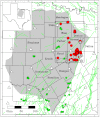
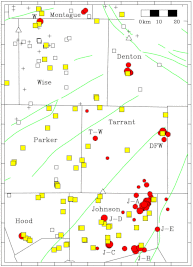
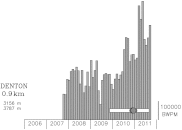
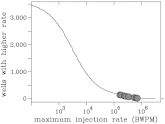
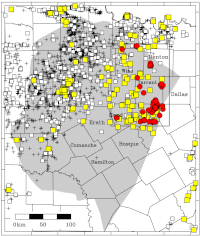
Similar articles
-
Mobile measurement of methane and hydrogen sulfide at natural gas production site fence lines in the Texas Barnett Shale.J Air Waste Manag Assoc. 2014 Aug;64(8):927-44. doi: 10.1080/10962247.2014.907098. J Air Waste Manag Assoc. 2014. PMID: 25185395
-
Gas injection may have triggered earthquakes in the Cogdell oil field, Texas.Proc Natl Acad Sci U S A. 2013 Nov 19;110(47):18786-91. doi: 10.1073/pnas.1311316110. Epub 2013 Nov 4. Proc Natl Acad Sci U S A. 2013. PMID: 24191019 Free PMC article.
-
Water use for Shale-gas production in Texas, U.S.Environ Sci Technol. 2012 Mar 20;46(6):3580-6. doi: 10.1021/es204602t. Epub 2012 Mar 9. Environ Sci Technol. 2012. PMID: 22385152
-
Aftereffects of Subduction-Zone Earthquakes: Potential Tsunami Hazards along the Japan Sea Coast.Tohoku J Exp Med. 2015 Oct;237(2):91-102. doi: 10.1620/tjem.237.91. Tohoku J Exp Med. 2015. PMID: 26399180 Review.
-
Growing seismicity in the Sichuan Basin and its association with industrial activities.Sci China Earth Sci. 2020;63(11):1633-1660. doi: 10.1007/s11430-020-9646-x. Epub 2020 Sep 22. Sci China Earth Sci. 2020. PMID: 33014023 Free PMC article. Review.
Cited by
-
Understanding rate effects in injection-induced earthquakes.Nat Commun. 2020 Jun 16;11(1):3053. doi: 10.1038/s41467-020-16860-y. Nat Commun. 2020. PMID: 32546793 Free PMC article.
-
Energy development linked with earthquakes.Environ Health Perspect. 2012 Oct;120(10):a388. doi: 10.1289/ehp.120-a388. Environ Health Perspect. 2012. PMID: 23026241 Free PMC article. No abstract available.
-
Effects of mechanical properties of the underburden on induced seismicity along a basement fault during hydrogen storage in a depleted reservoir.iScience. 2024 Jul 24;27(8):110553. doi: 10.1016/j.isci.2024.110553. eCollection 2024 Aug 16. iScience. 2024. PMID: 39206148 Free PMC article.
-
Wastewater Disposal Wells, Fracking, and Environmental Injustice in Southern Texas.Am J Public Health. 2016 Mar;106(3):550-6. doi: 10.2105/AJPH.2015.303000. Epub 2016 Jan 21. Am J Public Health. 2016. PMID: 26794166 Free PMC article.
-
Anthropogenic triggering of large earthquakes.Sci Rep. 2014 Aug 26;4:6100. doi: 10.1038/srep06100. Sci Rep. 2014. PMID: 25156190 Free PMC article.
References
-
- Suckale J. Induced seismicity in hydrocarbon fields. Adv Geophys. 2009;51:55–106.
-
- Nicholson C, Wesson RL. Earthquake hazard associated with deep well injection: A Report to the US Environmental Protection Agency. Washington, DC: US Geological Survey Bulletin 1951; 1990.
-
- Majer EL, et al. Induced seismicity associated with enhanced geothermal systems. Geothermics. 2007;36:185–222.
-
- Davis SD, Pennington WD. Induced seismic deformation in the Cogdell oil field of West Texas. Bull Seismol Soc Am. 1989;79:1477–1495.
-
- Holland A. Examination of Possibly Induced Seismicity from Hydraulic Fracturing in the Eola Field, Garvin County, Oklahoma. Oklahoma: Oklahoma Geological Survey; 2011. p. 28. Open File Rept. OF1-2011.
Publication types
MeSH terms
Substances
LinkOut - more resources
Full Text Sources
Other Literature Sources
Medical

